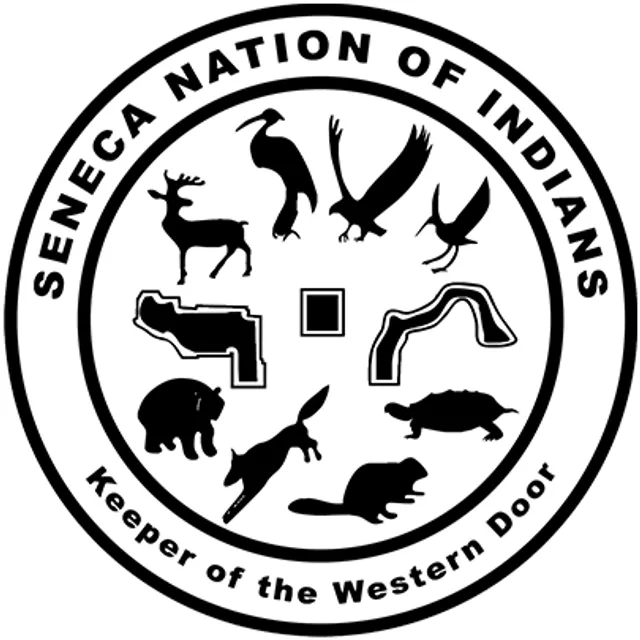
The Seneca Nation
The Seneca Nation of Indians traditionally migrated as far as Quebec, Canada, to the present-day Ohio and as far south as the northern Carolinas, historically living in longhouses on the riversides. At the time of European arrival they were primarily located along the Genesee Valley; however, currently the Seneca Nation is located strictly in Western New York. The Seneca Nation of Indians consists of five territories that are adjacent to the counties of Allegany, Cattaraugus, Chautauqua, Erie and Niagara, an area of the state where communities are primarily rural in character. The territories are not contiguous and each parcel is unique in its economic, social and environmental profile. With 53,891 acres, the Seneca Nation controls and holds a significant land base in Western New York. Like Oneida, The Seneca Nation is one of six nations of the Hodinöhsö:ni´. Known as the “Keeper of the Western Door,” as the westernmost of the Six Nations, traditionally relied heavily on trade, agriculture, fishing and hunting.
Having lived in these areas for thousands of years, no documentation exists of the first contact with Europeans, though 1534 is the year Jacques Cartier encountered Iroquoian-speaking people for the first time on Turtle Island, people he called Laurentian Hodinöhsö:ni´. This appears to be the first historical reference to any Iroquoians meeting the Europeans. Cartier kidnapped two sons of Chief Donnacona of the Stadacona settlement and brought them to France. From speaking with the victims, Cartier recorded a Laurentian Hodinöhsö:ni´ language.
Contact began to slowly increase over time. The 17th century included visits by Captain John Smith to the Chesapeake Bay (1608) and young Frenchman Etienne Brule who was tasked with recording European contact with Seneca villages (1608). In 1609, French explorer Samuel de Champlain brought sixty Algonquian allies to battle with Hodinöhsö:ni´ on the shore of Lake Champlain. This was the first battle fought using European firearms, losing three chiefs, and the beginning of a longstanding hostility between the Nations.
In 1615 Brule,with a dozen Hurons, returned to the Susquehannocks, both enemies and trade competitors with the Hodinöhsö:ni´, in an attempt to wage war. When Brule returned to the Huron in 1616, he reported that he was captured by the Seneca and spent time in their villages before escaping, possibly the first recorded instance of Europeans visiting Seneca villages, though likely white traders ventured into Seneca territory at an earlier date. During the seventeenth century, the Seneca are also credited with having absorbed the Erie and other communities in the west as a way of controlling the fur trade and bringing other communities under the umbrella of the Confederacy.
In 1677, with the Dutch leaving North America, the Seneca and the Hodinöhsö:ni´ Nations formed an alliance with the English via the Covenant Chain agreement. By 1687, relations with New France were not good. France’s Canadian colony acquired a new governor, Jacques-René de Brisay, the Marquis de Denonville, who led a French invasion of three thousand men into Seneca homelands. The French encountered mostly women, elders, and children. The invading army was most effective in destroying food stores and that year’s crop. Quickly he retreated across Lake Ontario to New France before the Seneca and warriors from the rest of the Hodinöhsö:ni´ Confederacy could retaliate.
During the American Revolution the Seneca fought with the British against the colonies. On November 11, 1794, the Seneca (along with the other Hodinöhsö:ni´ nations) signed the Treaty of Canandaigua with the United States that was meant to establish peace and friendship and affirm land rights in the state of New York. As settlers were making their way West of New York, and several treaties were signed which colonized their lands. The Treaty at Buffalo Creek (1838) would cede all of the Seneca territory; Seneca pressed for a new Treaty and in 1842, a compromised treaty was signed giving a portion of the territory back. Tonawanda and Buffalo Creek were lost and those Tonawanda who refused to leave had to purchase back their own land.
All of this upheaval and political unrest caused tension among the Seneca people. At a political convention in 1848 held on the Cattaraugus Reservation, a constitution was signed that eliminated the traditional clan controlled chief system and founded the Seneca Nation of Indians. The Tonawanda community of Seneca has continued with the traditional system. In Oklahoma, a caravan of several hundred Seneca, along with peoples from other communities, migrated and settled in that region.
Currently, unlike anywhere else throughout the United States, a city, Salamanca, New York, lies completely on lands held by a Native Nation, the Seneca Nation of Indians. The city holds a lease with the Seneca Nation and is governed by many overlapping entities that include City Government, Seneca Nation Government, New York State Government and US Federal Government. Salamanca residents total 5,686 and are diverse in nature, with many low-income families. The city is governed and mostly operates as an average municipality, with the exception they are obligated to recognize the Seneca Nation as landlord. Salamanca is one of the poorest cities in the United States, though it exhibits vast opportunities for economic development. Recently, the city and the Seneca Nation have agreed to work together to support common goals that will benefit all residents.
Approximately 8,000 people are currently enrolled as Seneca Nation citizens, about half of which live off-territory. Seneca culture remains strong in language, art, music, dance and sport; and the Nation boasts many cultural, educational and economic opportunities. The Onöhsagwë:De’ Cultural Center, in Salamanca, NY, holds an extensive collection of Hodinöhsö:ni’ historical and traditionally designed decorative and every-day-use items, as well as other items of matrimony.